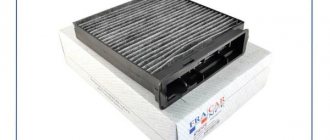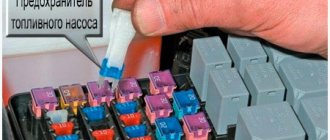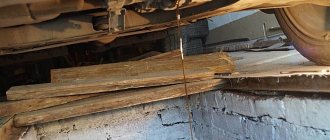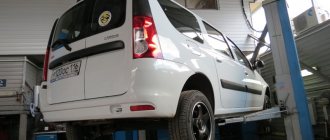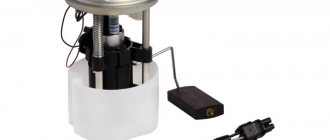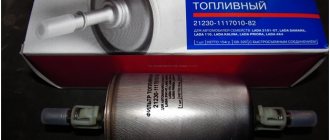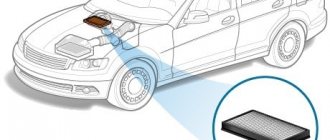There is a removable module inside the fuel tank. In addition to the fuel pump and pressure valve, it contains Almera Classic fuel filters. There are two of them, since the car uses a two-level fuel purification algorithm. The lower or coarse filter (mesh) is located in the place from where gasoline enters the fuel intake module. A thin filter is located at the top of the pump housing. It collects the smallest particles of dirt.
Filter location
The first thing you need to determine before starting the procedure is where the filter is located, which is responsible for removing contaminants from the fuel. In the Japanese model, this part is located in the tank in a separate module, inside which the pump is located.
This element consists of two filters, one of which (located near the inlet) removes large particles, and the second (installed at the bottom of the block with the fuel pump) removes small ones.
Replacement instructions
You can determine if a component is broken by the jerking of your Almera Classic H16 that occurs when the car is driven at high speed (more than 80 km/h); in some cases, the car begins to shake. In order to avoid fuel filter damage, it is necessary to fill your car with exclusively high-quality gasoline without any impurities.
The fuel pump itself on the Almera Classic and N16 models is located in the fuel tank. A special feature of the Almera Classic brand is the combined, one-piece design of the fuel pump with a cleaning filter. Replacing it at a service station will not be cheap, so if the problem is in the last component, you can try to clean or replace the mesh, which we strongly do not recommend doing.
Fuel pump cover under the seat
- First, remove the rear seat cushion. To do this, you need to relieve the fuel pressure. To do this, look under the dashboard on the left side and open the fuse box. On the top of the cover there is a diagram that will help you find the fuse responsible for the operation of the fuel pump (usually this 15-amp fuse is marked). We need to remove the fuse and then start the car. After a few seconds it will stall. You need to do this two or three more times until the engine stops starting altogether. To completely relieve the pressure, you must perform this procedure several times with an interval of no more than 60 seconds.
- Then you need to remove the filler cap and relieve the pressure inside the gas tank.
- Next, take a wrench and unscrew the three black bolts (usually they are plastic, very rarely metal), and then remove the inspection hole cover.
- Having done this, you will see a white container in which the fuel pump itself, which is a metal cylinder, is located.
Removing the Nissan fuel filter
- Then you need to remove the return hose by carefully pressing the latch.
- We take a previously prepared container and place it under the hose - about 300 ml of fuel should flow out of it.
- We also remove the second hose (fuel will not flow from it). It is important to remember that the hoses must be handled carefully so as not to damage them.
- Next, disconnect the connector with the harness and the float for measuring the gasoline level in the tank and take out the gasoline pump assembly.
- Now we need to carefully disconnect the gasoline hose.
- After removing the float with another sensor, you need to remove the pump casing.
- Now you have reached the fuel filter. We put the new fuel pump and filter in place in reverse order (if you decide to do it “the right way”). If you decide to only clean the fuel pump, then do this, or change the screen on it and also reassemble the entire system in the reverse order.
Don't forget to put back the fuse that controls the operation of the pump. Some craftsmen, after replacing the fuel pump, forget about the fuse, as a result of which they spend another half a day looking for a defect. Without this fuse, the car will not start.
Removing the fuel pump
First you need to remove the rear seat element. The gasoline pressure must be relieved in the fuel line. The fuse box, which is located under the dashboard on the driver's left side, must be open. Usually on the top (cover) there is a designation with which this fuse is easy to find, because it is marked FUEL PUMP. It should be in the 2nd column (4th from the top), and also have the designation 15A. The fuse must be removed from its socket. Start the car, and after 3-5 seconds the engine will stall on its own. This action must be repeated until the engine no longer starts (usually this works after 3-5 attempts). Then wait a minute and repeat the action. If everything is done correctly, then the pressure will actually be released to the maximum, in other words, to the end.
In this case, if you do not want to look for the fuse, you should disconnect the connectors from the flange (located under the seat) of the fuel tank. There is no need to remove the hoses right away.
It is necessary to remove the filler cap and then relieve the internal pressure in the gas tank. We unscrew three dark-colored plastic bolts and remove the hole cover for inspection. Afterwards, the large plastic nut must be unscrewed by hand. We should be able to see a snow-white glass, in the place of which the gas pump is installed. This is a cylinder measuring 10 by 3 centimeters. Some models have an internal mesh, which is usually yellow with dirt.
HOW TO REPLACE THE FUEL PUMP FOR A NISSAN ALMERA CLASSIC?
Changing the fuel pump and filter on a Nissan Almera Classic
. THIS VIDEO IS NOT.
Replacing the fuel pump on Almeria
They cleaned the gas receiver and changed the pump, but did not change the filter. And the speed rose, but the start-up was not very good.
The return hose must be removed by accurately pressing the plastic latch. This hose extends from the beginning of the engine, as well as an arrow that is directed to the fuel pump. With a little pressure, approximately one small glass of gasoline will flow out of the hose. The second hose will also need to be disconnected, but nothing will leak out. The most important thing is that you need to be careful so that they are not damaged when removing them.
The connector with the harness must be removed and the fuel level meter, that is, the float located in the tank, disconnected. And then you need to remove the fuel pump itself.
Now you can start cleaning the fuel pump itself.
Selecting a filter
Original fuel filters for Nissan are not available for sale separately. They can be purchased and replaced only as an assembly with a fuel pump. The part number for ordering the product is 17040–95F0B.
Analogs
As an analogue of the original filter mechanism for the fuel system of Nissan cars, they use devices from other automakers. Most often, a coarse filter from the Hyundai Accent (product code 31090–25000) or the domestic VAZ 2110–12 is used for this purpose. These parts, unlike the original, have a different shape for the installation part, which will have to be trimmed a little. From original spare parts, you will need a rubber ring to seal the module cover (17342–95F0A). Usually it has to be changed after damage due to careless dismantling of the cover.
The choice of fine filters is a little richer - this is the original part from Accent (article 31911–25000) or its SCT analogue with the number ST 399. These devices differ from the original Nissan filters in the location of the mounting point of the fuel pressure regulator. When installing them, you need to slightly trim the plastic body of the cup where the fuel pump is located. The installation of such elements has been repeatedly tested on Nissan cars produced in 2006, 2007 and 2008. For the Almera G15, the suitable filter is Francecar FCR 210141, which was successfully tested on a 2014 model.
Detailed description of replacing the fuel filter and fuel pump
Replacing the Almera Classic fuel pump and filter must be performed in a sequence that will be discussed in detail below. The work will be carried out in three stages: extraction, disassembly and reinstallation.
Required parts and tools
The gasoline pump and filter components are replaced with the following tool:
You also need to prepare spare parts:
- coarse and fine filter
- fuel pump
- fuel tank flap gasket – 17342-95F0A
- hoses resistant to oil and gasoline, as well as clamps for fixing them
- rags
- solvent
- container for receiving remaining gasoline from the system.
Filter elements and a gasoline pump are selected according to the previously presented articles.
Removing the fuel module
Before dismantling the Almera Classic fuel module, it is necessary to completely relieve the gasoline pressure in the car system. To do this, repeat the following procedure three times at intervals of several minutes:
- Remove the fuse from the interior mounting block, which is responsible for the fuel pump;
- Start the Nissan Almera Classic engine;
- Wait until the engine stalls.
In the future, you will need to move into the car interior and perform the following steps:
- Fold down the lower part of the rear sofa;
- Clean the hatch cover and the area around it from dirt and dust;
- Remove the hatch cover by unscrewing the fasteners;
- Disconnect the supply cable from the fuel pump;
- Start the engine, wait until it stalls;
- Place the container, loosen the clamp of the fuel supply hose, remove the hose and lower it into the container. Wait until the remaining gasoline drains out.
Now you can proceed directly to dismantling the fuel module.
- Using the handles of the gas wrench, unscrew the locking ring of the module. It is necessary to rest them against special plastic protrusions, applying force in a counterclockwise direction;
- Carefully remove the module so as not to damage the fuel level sensor float
Let's sort it out
We begin disassembling the Almera Classic fuel module. It is recommended to follow the following sequence of actions:
- Using a flat blade screwdriver, press out the three plastic clips to dismantle the lower housing;
- The supply wire is disconnected from the gasoline level indicator;
- Holding three clamps, the pump and Almera Classic filter elements are removed;
- By loosening the clamp, the pressure sensor is disconnected;
- Use a rag soaked in solvent to wipe the internal cavity of the housing;
- The condition of the fuel pump, coarse and fine filters is assessed. The first is located at the bottom of the device and can be removed by hand. The second is secured with plastic latches, which should be released using a flat-head screwdriver;
- We compare prepared spare parts by size;
- All sealing rubber bands are removed from the fine filter.
Installation of a new fuel pump, filters and assembly
The process of reassembling the Almera Classic fuel supply system begins with the installation of sealing gaskets in the fine filter. Then:
- The fuel pump and fine filter element are mounted in its seat;
- Depending on the prefilter, it may be difficult to install. They are due to the presence of two plastic protrusions that prevent the element from being fixed to the fuel pump. Therefore, you will need to grind them off with a file;
- On the pressure sensor you will need to cut a suitable pipe, cutting off the curved part;
- When installing the pressure sensor into the seat, you will need to break off part of the fuel receiver housing, which will interfere with installation;
- We use an oil and gasoline resistant hose to connect the parts of the previously cut fuel pressure pipe. In this case, it is necessary to secure both ends of the hose with clamps. The sensor is secured using the original clamp;
- We install the lower part of the fuel module in place, having previously lubricated the fuel supply pipe. This will allow you to align the tube with the sealing rubber bands without excessive resistance.
All that remains is to install the module in its seat in the reverse order. Do not close the hatch cover until the fuel system is checked. To do this, start the engine and if everything is in order, then turn off the engine and screw the cover into place.
How to change it yourself?
Sometimes car owners turn to an official dealer to replace Nissan Almera Classic fuel filters. But more often than not, many people prefer to do this work themselves.
Preparation
Before replacing the fuel filter, you need to prepare tools and auxiliary materials.
A short list of what you need:
- wrench 10;
- gas key;
- a screwdriver with a narrow flat and cross-shaped blade;
- cleaning agent (acetone, solvent or carburetor cleaner);
- an empty, stable container with a volume of 0.5–1.0 liters for draining remaining gasoline from the main line;
- rags for collecting spilled fuel.
Stages of work
After preparing the tool, you can begin work on removing and replacing parts.
Step by step sequence:
It is necessary to relieve pressure in the fuel system. To do this, you need to find the pump fuse in the mounting block, which is located under the instrument panel in the area of the driver’s left foot. It is marked on the diagram on the block cover as “fuel pump”. You should remove it from the socket. Then you need to start the car engine. It will run for a short time and then die. It is advisable to repeat this procedure several times with an interval of about a minute between starts. While the engine is running, open the filler neck of the gas tank to equalize the pressure with atmospheric pressure. Fold back the rear seat cushion, under which the tank is located. It has a mounting socket in which the fuel module is installed. Before removing the cover, it is advisable to wipe off dust and dirt around the socket. Using a 10 mm wrench or a Phillips screwdriver, you need to unscrew the three bolts securing the cover. Underneath there will be a cylindrical module made of white plastic with a black ring around its circumference. If the fuel pressure has not been relieved using the method described above, it can be lowered with the pump power connector disconnected. The procedure for starting the engine is similar. Then you need to install a container next to the drain module. By pressing the clamping ring, you need to pull off the fuel supply hose, previously wrapped in rags, and quickly throw it into the container
It is important not to spill fuel on the interior components, since gasoline will evaporate from them for a very long time. Up to 0.2–0.3 liters of fuel can leak from the line. Next, unscrew the module cover, which is secured with a ring nut (black ring with protrusions around the perimeter of the module)
The nut is tightened quite tightly and access to it is inconvenient. To unscrew, use the handles of a gas wrench. Now you can get the fuel pump module assembled with filters. In this case, it is important not to damage the float of the fuel level meter installed in the lower part of the device. You need to remove the top cover of the module by bending the three blade clamps with a flat screwdriver, and disconnect the connectors from the fuel level sensor and pump. Sometimes the wires may be held together with a nylon tie that needs to be cut off. After disconnecting the connectors, you can remove the pump with filters from the module housing. It is secured with three clamps that must be pressed while simultaneously pulling out the pump. The pressure regulator is located on the clamp and can be removed very easily. Then you need to clean the plastic cup of the module from the dirt accumulated inside. Next, an external inspection of the pump is carried out, as well as repair and maintenance of structural elements. The coarse filter is located on the bottom of the mechanism and can be easily removed by hand. The fine cleaning device is located at the top of the pump and is secured with two plastic clips. To bend them, use the tip of a flat screwdriver. When dismantling the filters, it is important not to forget to remove the cuffs from the pump fittings, which are installed in the new cleaning mechanisms. Then you can change the filtration devices and begin assembly in reverse order. In this case, you need to modify the pressure regulator valve by cutting its tube and extending it with an insert from a gas-resistant hose.
You can watch the procedure for replacing fuel filters in a video from user Azat Alikberov.
Article number and approximate cost of the branded fuel filter Nissan Almera Classic and its analogues
Coarse and fine filters are included in the fuel cup. They do not have their own article numbers and are not sold separately from the module. Therefore, it is impossible to purchase branded filters on Almera Classic without purchasing a complete glass.
The original fuel module has part number 1704095F0B. Its cost varies from 12,000 to 18,000 rubles. There are also analogues of the original glass on sale. The table below shows the best alternatives to the original fuel module.
Table - Analogs of the fuel module for the Nissan Almera Classic car
| Company manufacturer | Article number | Estimated cost, ruble |
| Messmer | 770065A | 2300-2700 |
| Bosch | 986580908 | 2800-3500 |
| Blue Print | ADG06819 | 2200-2600 |
| HKT | GIP522 | 2400-3000 |
| Krauf | KR7537M | 3200-4500 |
The fuel module has a very high price, so it is irrational to completely change it if only the filters are clogged. Therefore, car owners found a way out of this situation.
Despite the fact that the original fine filter is not available for sale separately, there are identical consumables for other machines from third-party manufacturers. The table below shows brands of fuel purifiers that are suitable for the Almera Classic car.
Table - Fine fuel filters for a Nissan Almera Classic car
| Brand | vendor code | Approximate price, ruble |
| SCT | ST399 | 300-350 |
| Japan Parts | FCH22S | 400-450 |
| Nipparts | J1330507 | 300-350 |
| AMP | FF0820 | 500-600 |
| Sakura | FS2813 | 720-1000 |
In addition to the fine fuel filter, third-party manufacturers also produce meshes. The most suitable consumables for restoring a glass are those presented in the table below.
Table - Fuel filter screens for a VAZ 2112 car with a 1.5 liter engine
| Firm | Catalog number | Approximate price, ruble |
| WEBER | 21121139200 | 55-100 |
| Cliff | 21121139200 | 95-120 |
| FARET | 21121139200 | 90-150 |
| Zommer | KRFS2112 | 130-210 |
| StartVolt | SFF0115 | 50-110 |
Fuel filter for Almera Classic – which one to buy?
The manufacturer does not provide for a separate replacement of the main fuel filter (as, in principle, other components of this fuel unit). Everything should only be changed as an assembly, as a whole module. Therefore, a separate article is not provided for both the filter and the mesh.
You can also install one of the analogs of the assembled module, since they are usually 1.5 - 2 times cheaper.
| Manufacturer | vendor code | price, rub. |
| Ruei | 2457 | 3600 |
| Cross | KN17-03055 | 6000 |
| ASParts | ASP2457 | 3700 |
Since replacing the entire module assembly at once is quite expensive, and is not always justified (since only the filter may become clogged, or the pump may fail, but everything else may be in good condition), many drivers often change the design of the unit, making a tie-in, and connect any remote fine fuel filter.
The second option for upgrading the fuel module is to install a fine filter from other fuel units that require its replacement. But for this, a cutout is usually made in the module body for the pressure regulator, since on all analogues it is located in a different place from the original.
In the table below you can see which fuel filter you can buy for the Nissan Almera Classic with the specified article number and price.
| Manufacturer | vendor code | price, rub. |
| SCT | ST399 | 300 |
| Japanparts | FCH22S | 370 |
| Hyundai/Kia | 319112D000; from Hyundai Elantra III (XD) | 1400 |
As for the mesh filter, if necessary, you can simply wash it with a carburetor cleaner - Carb Cleaner. If a replacement is needed, then you can use one of the following analogues.
| Manufacturer | vendor code | price, rub. |
| Krauf | KR1111F | 100 |
| LADA | 1118-1139200 (from VAZ 2110-12) | 30 |
| Hyundai/Kia | 3109025000 | 340 |
When to change the fuel filter on Almera Classic?
According to the Almera Classic maintenance regulations, the manufacturer does not provide for replacing the fuel filter after strictly defined mileage periods. It is replaced as a whole, as an entire module, which in turn is designed for the entire service life of the pump. On average, the fuel pump becomes unusable between 100 thousand km and 200 thousand km.
If the fuel unit is upgraded independently (remote filter, or replaceable for collapsible modules), then it can be replaced every 45 - 60 thousand km. The filter mesh can be simply washed through one maintenance.
How often to change
The frequency of replacing the fuel filter on Nissan Almera N16 and Classic is not established by the manufacturer. The latter determines the timing at which it is necessary to install a new pump. As a result, the owners of the Japanese model had to empirically determine the frequency of this procedure.
According to the results obtained, in real operating conditions of the Nissan Classic, the fuel filter needs to be changed every 90 thousand kilometers. However, this parameter is not absolute. A number of motorists carry out the procedure after 12-15 thousand kilometers. This frequency is mainly due to the use of low-quality gasoline, which quickly clogs the coarse and fine filters.
This procedure should also be carried out if:
- failures in engine operation occur;
- the engine picks up speed jerkily (especially at speeds above 80 km/h);
- signs of tripping appear at different speeds.
Each of the above phenomena indicates that low-quality fuel is entering the engine.
And this may indicate problems with the filter elements.
Consequences of untimely replacement
If the fuel filters are not replaced in a timely manner, at best, the car simply will not start, since the pump will not be able to supply gasoline to the injectors in the required quantity. In this case, there is a risk of pump failure, since it is fully cooled and lubricated only when pumping fuel. In the worst case scenario, small particles of dirt will travel along the fuel lines to the injection system injectors and clog them. Sometimes this clog can be so severe that it cannot be cleared. In this case, the parts must be replaced.
vote
Article rating
If you don’t change it, what are the consequences?
A car consumes a lot of fuel over its entire service life. At around 100 thousand km, about 10,000 liters of fuel passes through the fuel system. Even the cleanest gasoline contains impurities and dirt, which are successfully retained by filters. Therefore, Nissan Almera Classic and other foreign cars use a two-level filtration system, which is much more efficient and lasts longer.
However, the mileage takes its toll. Over time, the filters themselves become clogged. The first symptoms of a poorly functioning filtration system are known to experienced car enthusiasts:
- engine loss of traction;
- work intermittently;
- increased fuel consumption (the pressure in the fuel system does not correspond to the nominal value);
- difficult startup (up to complete failure).
First, this leads to damage to the pump, since clogged filters cause disruptions in liquid pressure. Several such failures - and the mechanism stops pumping gasoline, the impeller rotates freely on the shaft. Almera Classic or N16 has a submersible fuel pump. It receives cooling by pumping fuel. No fluid flow - no cooling.
If dirt gets inside the injector, the result is even worse. The owner has to repair the entire fuel system, including the intake manifold and injectors. The latter, as is known, operate synchronously on the Almere Classic with distributed injection - in accordance with the valve timing (the electronic control unit receives signals from the phase sensor). The system reacts instantly to clogging of at least one of the injection elements. The engine stops starting and fuel consumption increases.
If you have the described symptoms, it is better not to hesitate. Contact DDCAR car service to replace the fuel filter. Our craftsmen will do this work for only 600 rubles. You can wait for the work to be completed in a cozy relaxation area with Wi-Fi.


